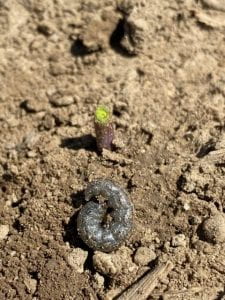Potato Leafhoppers have Arrived Back in New York

Potato leafhoppers (PLH) are back from their overwintering sites down south. They come up on storm fronts and get dropped out usually with the rain. The adults will feed and lay eggs into alfalfa plants. We are finding low numbers of adults this week. Second cut regrowth and new seedings are the most vulnerable. PLH feed by piercing and sucking the plant sap from the plant. The resulting hopper burn (yellow leaves) and stunting means that we missed our opportunity for timely management.
PLH management is based of plant height and leafhoppers per sweep. Cornell recommends taking five sets of sweeps with a sweep net (10 sweeps per set) per field and calculating a PLH (adults & nymphs, see chart) per sweep for each set. The economic thresholds for PLH are listed below. Many NY growers are now utilizing PLH resistant alfalfa varieties to protect against quality and quantity losses. Many university researchers are recommending increasing PLH regular thresholds by 3X. However, use regular threshold numbers (chart) for first year PLH resistant stands. After the first cut, use the 3X numbers.

Alfalfa weevils continue to be a nuisance in second cut regrowth and I hear many fields are hitting the treatment threshold of 50% tip feeding (shot hole) injury. I did hear that some were beginning to pupate. Look for the white lace covering surrounding the larvae. This is a good sign that their feeding is complete and no more injury will occur.
Black Cutworm Feeding Observed, More Still Arriving

All corn needs to be scouted! We have observed and have had multiple reports of black cutworms (BCW) cutting corn plants and over threshold. There are even reports of beet fields under attack! BCW moth trap catches continue to be high this week in Wyoming, Livingston and Seneca counties. Corn is not safe from BCW cutting until the V6 stage (6 collars visible) when it becomes too big to cut. We have some fields just reaching this stage where it was early planted. Remember, if 3 to 5% of the plants are missing or cut, spraying an insecticide is warranted.
Common armyworm (CAW) continues to be a no-show in the traps and in the field. Keep looking for blackbirds diving into the winter grains and CAW crossing the road in large numbers.



